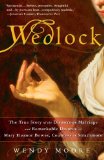Summary | Excerpt | Reading Guide | Reviews | Beyond the Book | Readalikes | Genres & Themes | Author Bio
The True Story of the Disastrous Marriage and Remarkable Divorce of Mary Eleanor Bowes, Countess of Strathmore
by Wendy Moore

Critics' Opinion:
Readers' Opinion:
First Published:
Mar 2009, 400 pages
Paperback:
Mar 2010, 400 pages
 Book Reviewed by:
Book Reviewed by:
Marnie Colton
Buy This Book
There was no doubt, in the case of the duel at the Adelphi, that the reputation of the woman in question had been grossly impugned. Since early December 1776, readers of Bate’s Morning Post had read with mounting interest reports of the amorous exploits of the recently widowed Countess of Strathmore. Despite having only just shed her mourning costume, the young countess had been spotted in her carriage riding through St. James’s Park engaged in a passionate argument with a military man whom the Post had named as Captain Stoney. Simultaneously fueling his readers’ titillation and moral outrage, the newspaper’s anonymous correspondent had speculated on whether the wealthy widow would bestow her favors on the Irish soldier or on a rival suitor, a Scottish entrepreneur called George Gray, who had recently brought home a small fortune from India. Even more scandalously, the Post suggested, the countess might find herself in the “arms of her F–n,” a thinly disguised reference to her own footman. Less than two weeks later, readers spluttered into their morning coffee as the Post divulged on successive mornings, first that the countess had broken with her “longfavoured- paramour,” presumably Gray, and next that she was planning to elope with him abroad.
If the readers of the Post harbored any doubts as to the impropriety of the countess’s conduct, these were briskly swept aside by a concurrent series of articles, in the form of a curious exchange of letters, that alternately condemned and defended her behavior. Written under a variety of pseudonyms, one side accused the countess of betraying the memory of her late husband, the Earl of Strathmore, whose death she was said to have greeted with “cold indifference,” and of forsaking her five young children in her blatant exploits with her various suitors. Equally forthright in her defense, the other side insisted that the young widow suffered “heart- felt sorrow” in her bereavement.
Whether or not the countess, in exasperation at the intrusion of the press into her private affairs, had provoked the duel to defend her honor was a matter of conjecture. One member of her house hold in London’s fashionable Grosvenor Square would later claim that the countess had declared that “the man who would call upon the Editor of that Paper, and revenge her cause upon him, should have both her hand and her heart.” By the middle of January 1777, the Irish army officer Stoney had stepped forward and taken it upon himself to act–in Bate’s words–as the “Countess of Strathmore’s champion.”
Given the vindictive nature of the articles naming both the countess and himself, Stoney had initially written to Bate demanding to know the identity of the writers. Somewhat surprisingly, Bate responded by insisting he did not know. In truth, this was not unlikely. The lurid public interest in the sexual misdemeanors of Georgian celebrities had spawned a highly organized industry in gossip- mongering. Certain newspapers even provided secret post boxes so that those with salacious information could anonymously submit their claims directly to the printers, while newspaper editors frequently had neither sight nor supervision of such material prior to publication. Although publishing inflammatory accusations, without the least effort made to check their veracity, raised the serious prospect of being sued for libel, publishers often gauged that the boost in their circulation figures justified the risk.
Bate’s protestations of ignorance, coupled with his profuse apologies, did little to mollify Stoney, who took the somewhat progressive view that an editor should assume responsibility for the material published in his newspaper. Bate had therefore little option but to agree to a meeting with the irate soldier. According to their record of events, this meeting took place on the evening of Friday, January 10, in the Turk’s Head Coffee- house in the Strand. Here, in the convivial atmosphere of the fuggy coffee- house, Bate had managed to convince Stoney that he had been innocent of any involvement in the articles and promised to ensure that no more insults would appear. And so when Stoney opened the Post the following morning to read yet further revelations about the countess’s love life, he was apoplectic. The latest article, which reported that “the Countess of Grosvenor- Square, is frequently made happy by the visits (tho’ at different periods) of the bonny, tho’ almost expended Scot, and the Irish widower,” seemed almost calculated to incense him. Immediately, Stoney dashed off another letter to Bate demanding his right “to vindicate the dignity of a Gentleman” by seeking satisfaction in the traditional manner. He concluded by naming an old army friend, Captain Perkins Magra, as his second who would arrange events.
Excerpted from Wedlock by Wendy Moore Copyright © 2009 by Wendy Moore. Excerpted by permission of Crown, a division of Random House, Inc. All rights reserved. No part of this excerpt may be reproduced or reprinted without permission in writing from the publisher.





The Funeral Cryer by Wenyan Lu
Debut novelist Wenyan Lu brings us this witty yet profound story about one woman's midlife reawakening in contemporary rural China.
Your guide toexceptional books
BookBrowse seeks out and recommends the best in contemporary fiction and nonfiction—books that not only engage and entertain but also deepen our understanding of ourselves and the world around us.